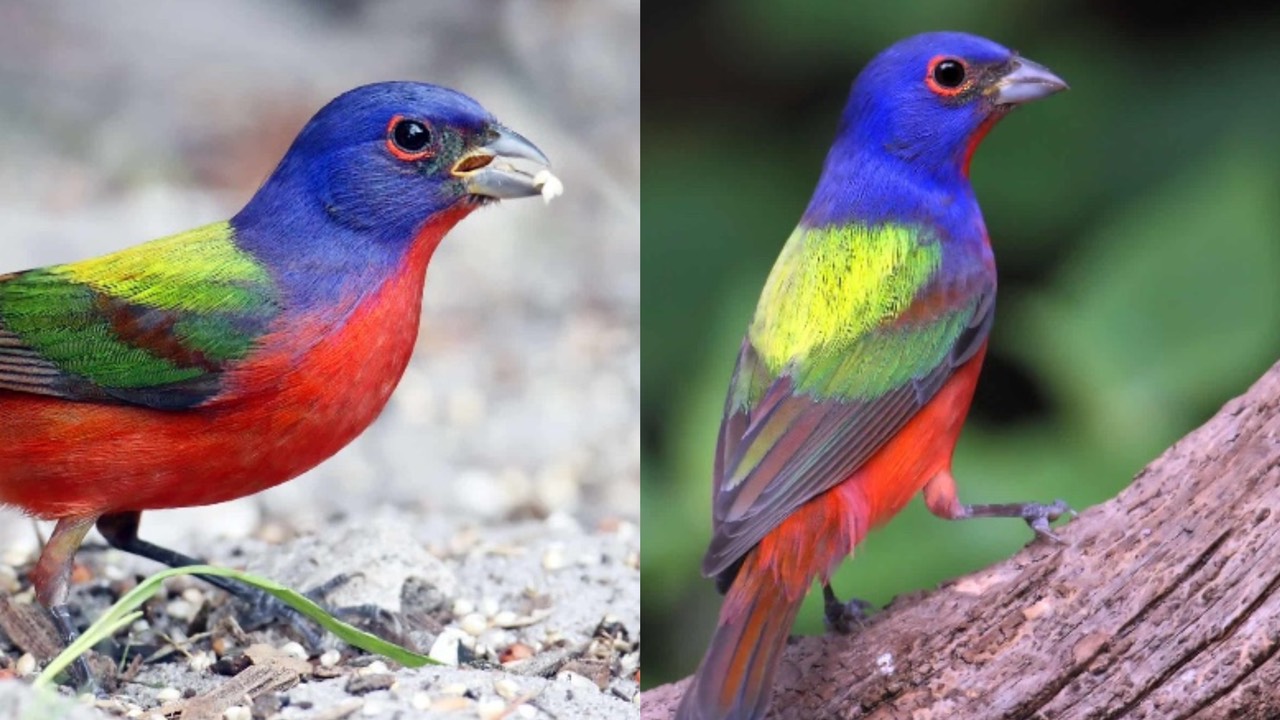
Looking for some colorful facts about the gorgeous painted bunting? You’re in the right place! Apart from telling you some awesome facts, this post will help you look in the right places and use the right feeds when trying to attract these gorgeous birds to your yard.
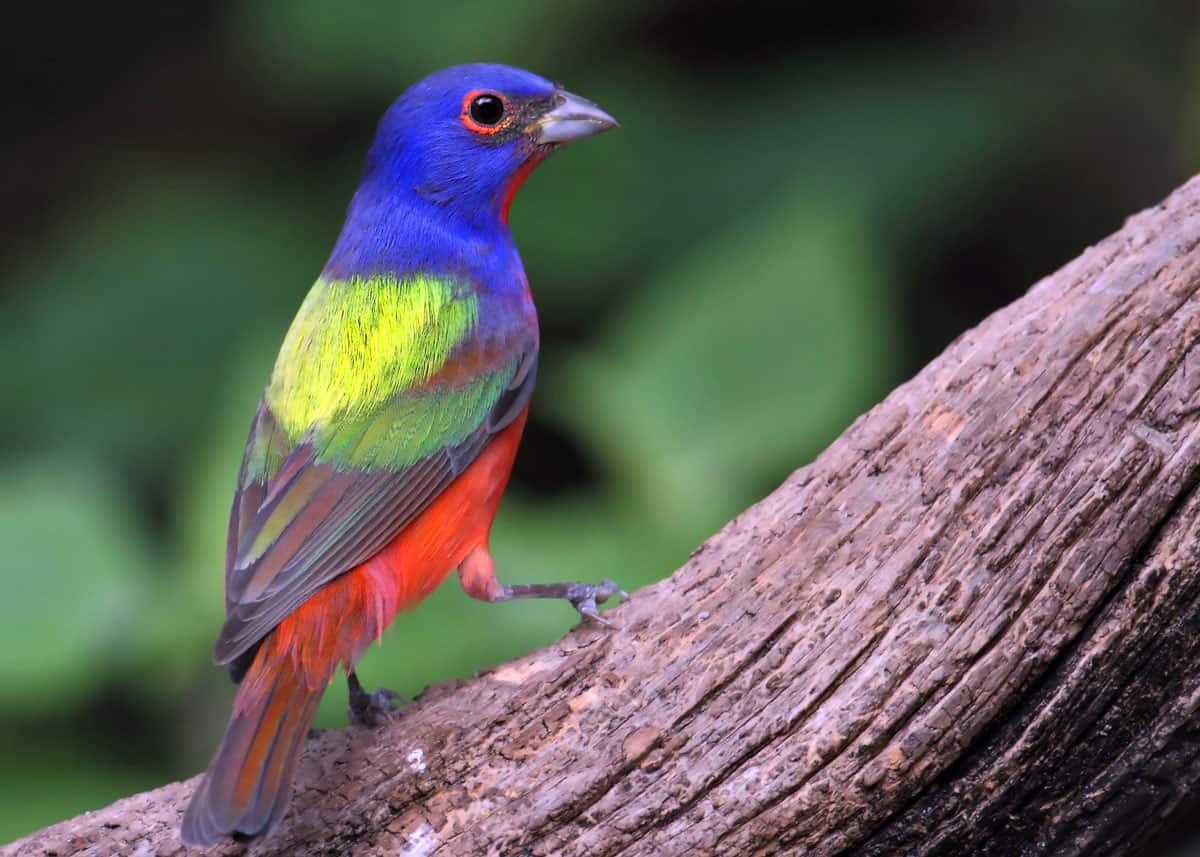
27 Painted Bunting Facts
Painted buntings are like rainbows in flight. This is probably why they’re nicknamed nonpareil or “unparalleled.” They’re definitely a species to look for during your next bird-watching trip!
Are you ready to learn some cool painted bunting facts? Let’s get to it!
1. What is the painted bunting?
Painted buntings are bright, colorful, cool birds that are always fun to spot through a pair of binoculars. They’re part of the cardinal family. Interestingly, they’re the only species of cardinal that’s native to North America.
2. What does the painted bunting look like?
Painted buntings are known for their eye-popping plumage. Males have blue heads, green backs, and red underbellies.
They can also be streaked with yellow, orange, purple and brown.
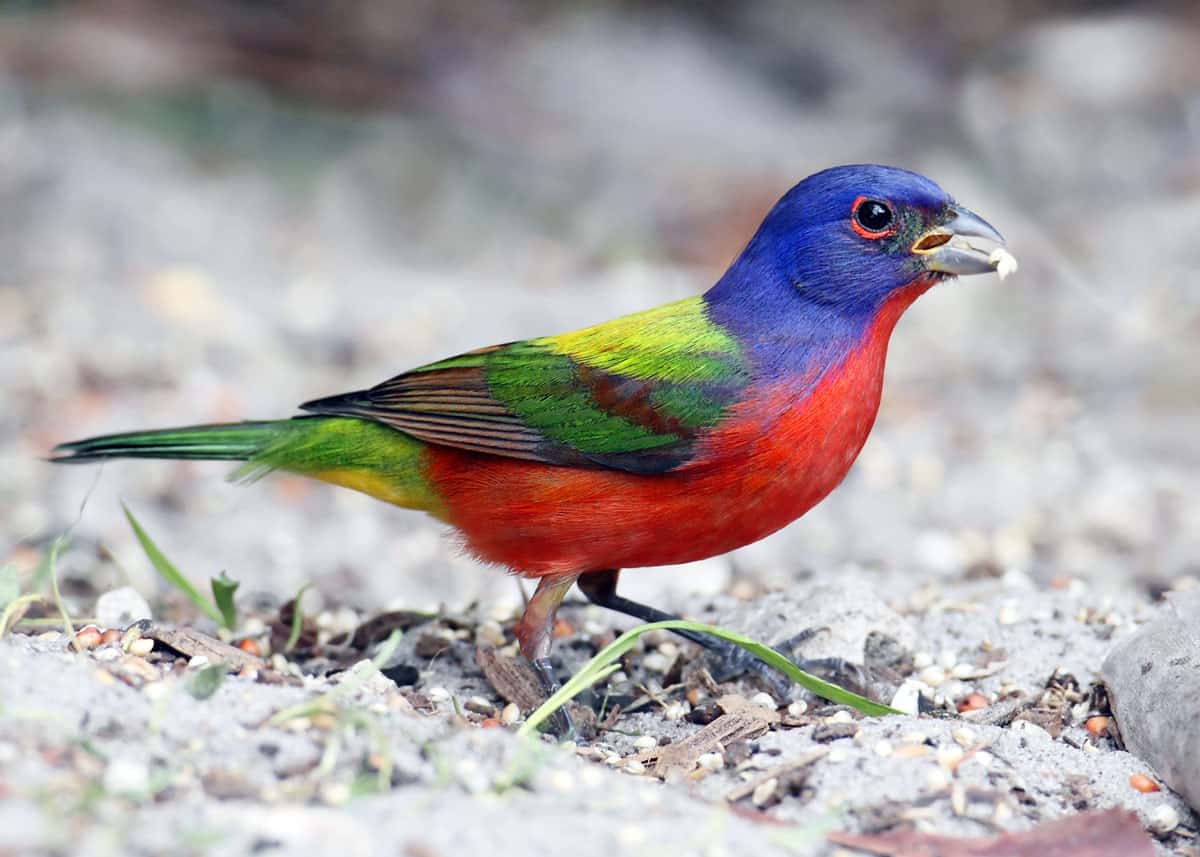
A male painted bunting
Females and their young are various shades of yellow-green.
Females will keep their coloring throughout their lives, but young males will grow their rainbow feathers after reaching maturity.
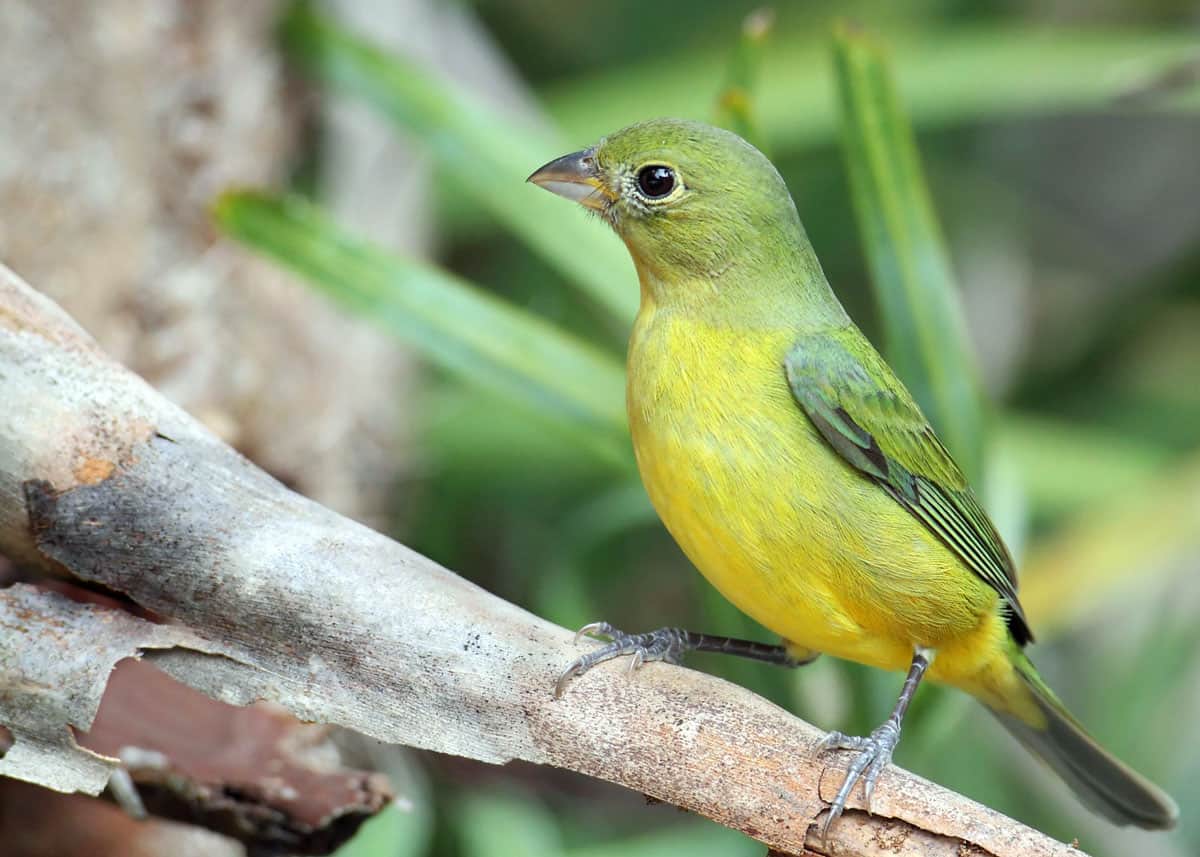
A female painted bunting
3. How big is a painted bunting?
Painted buntings measure around 4.7 – 5.5 inches (12-14 cm). This makes them a relatively small bird, especially when compared to others in the cardinal family.
Breeds like the northern cardinal can reach heights of 8 – 9 inches (20-22 cm).
4. How much does a painted bunting weigh?
Painted buntings weigh roughly 0.46 – 0.67 ounces (13-18 gm).
5. What is the painted bunting’s wingspan?
When they stretch out, painted buntings can almost double their body length.
Their wingspan is a whopping 8.3 – 9.1 inches (20-22 cm)!
6. Are painted buntings friendly?
While they aren’t hostile to humans, it would be a stretch to call painted buntings “friendly.”
They engage in a lot of aggressive behaviors with other members of their species, and when they’re not fighting each other, they’re hiding from predators. They aren’t the type of bird to land on your finger.
7. Are painted buntings aggressive?
These colorful creatures have a bit of an angry streak to them. For example, males are extremely territorial, and they’ll defend their habitats with violent posturing and aggressive behavior.
This is one of the reasons why painted buntings are so easily captured for the exotic pet trade; when decoys are put in their territory, they’ll fly over in a frenzy to drive them off.
Males have also been known to attack each other over food and females. They’ll peck, scratch, and strike with their beaks and wings, and they can cause quite a bit of damage before someone gives up and flies away.
The aftermath of a painted bunting fight can involve a lot of bloody wounds and torn-out feathers. They even kill each other on occasion.
8. How long do painted buntings live?
According to the Bird Banding Laboratory, the average lifespan for a painted bunting is 126 months or 10.5 years.
They might last longer in captivity without the threat of predators, habitat loss and fights with other members of their species.
9. Is the painted bunting endangered?
Good news: The painted bunting isn’t going anywhere. It’s classified as “least concern” on the extinction scale of the International Union for Conservation of Nature (IUCN), so there’s no need to fear for its status in the wild.
There was a time when the species was considered “near threatened,” but that was years ago, and their population has both increased and spread since then. There are currently 14 million mature adults scattered across multiple countries.
Long story short, painted buntings aren’t in any danger for the time being.
10. What seeds do painted buntings eat?
Painted buntings love their seeds. They’ll use their feet to drag entire plant stems to the ground so that they can munch on the seeds that they’ve “captured.”
They enjoy fig, pine, rose, sedge, dock, and wheat seeds.
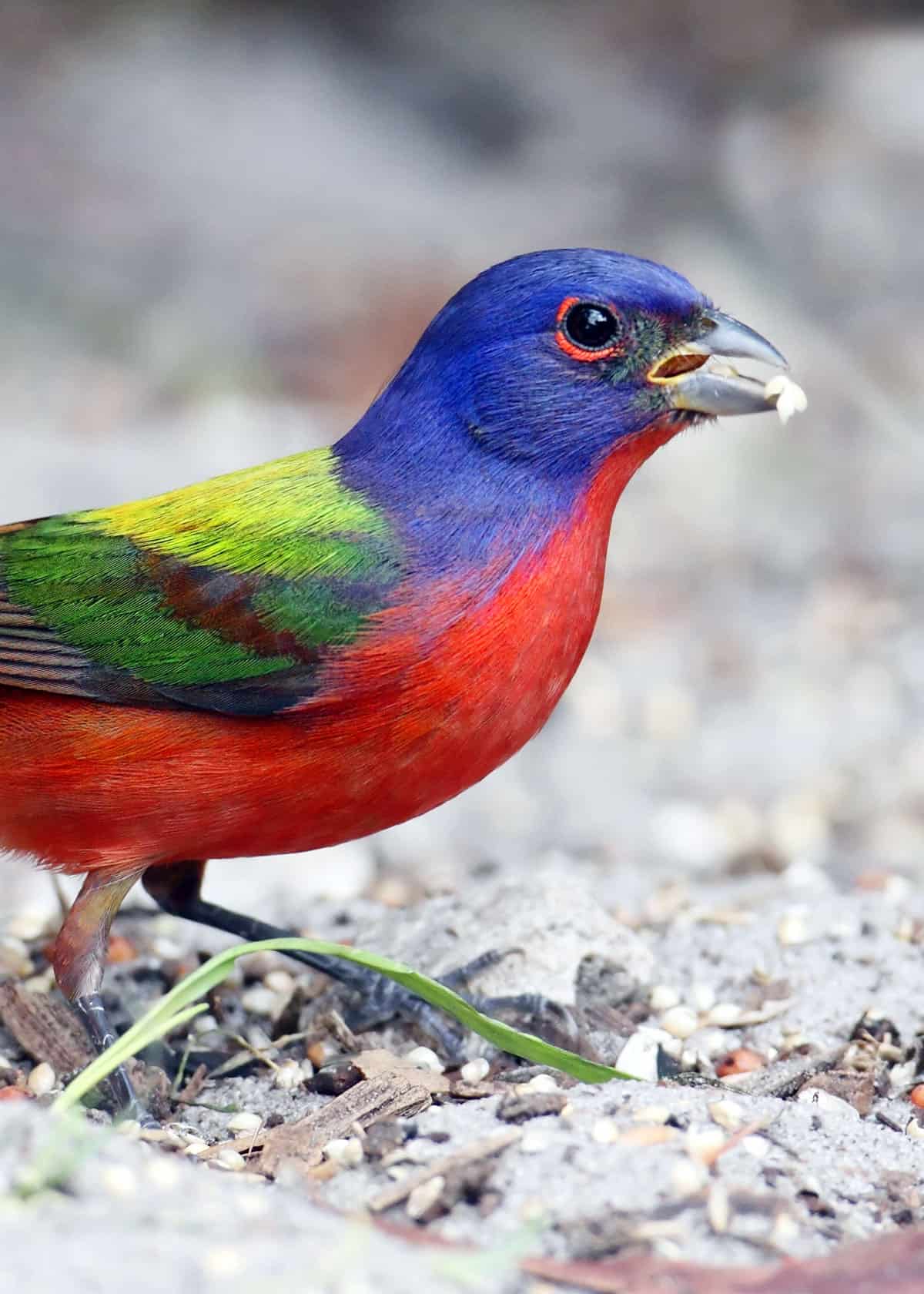
In addition to seeds, painted buntings also consume a variety of insects. This behavior is usually seen during breeding season when they need the protein for their hatchlings.
They’ll munch on flies, worms, bees, beetles, and grasshoppers; they’ll eat both spiders and the bugs that the spiders have caught. It isn’t uncommon for painted buntings to raid a spiderweb and pick it clean.
Occasionally, a painted bunting will kill a small invertebrate like a snail. This is more difficult and time-consuming than catching a caterpillar, but it can provide a lot of sustenance at once.
11. What is the painted bunting’s Latin name?
The painted bunting’s scientific name is passerina ciris.
There are also two sub-species, passerina ciris ciris and passerina ciris pallidior, that live in various parts of the southeastern U.S. and Mexico. There’s no real difference to them except for the regions where they live.
12. What eats a painted bunting? Predators
One downside to the colorful plumage of the painted bunting is that they’re easy prey for a number of animals.
Between snakes, shrikes, hawks and other predatory birds, they’re frequently under attack. Their nests are particularly vulnerable targets since animals like to steal and eat their eggs.
13. How do painted buntings reproduce?
Mating season is between April and August. Males will signal to females by puffing up their chests and spreading their feathers like a tiny, colorful peacock.
Once they’ve made eggs, it’s time to make a nest to go along with them. Females will weave together grasses, stems, weeds, leaves, twigs and other detritus to create a solid, two-inch cup shape. They’ll also attach it to the stems or roots of nearby plants to ensure its sturdiness.
Mom usually makes these nests in low-lying foliage, but if no shrubs or thickets are available, she’ll fly to higher ground in a proper tree. The security of the nest is the most important thing.
14. Do painted buntings mate for life?
It’s not quite accurate to say that they mate for life, but painted buntings do form monogamous relationships during mating season, and they usually produce several broods of eggs with the same partner.
However, these pairs might or might not come together again during the next mating season.
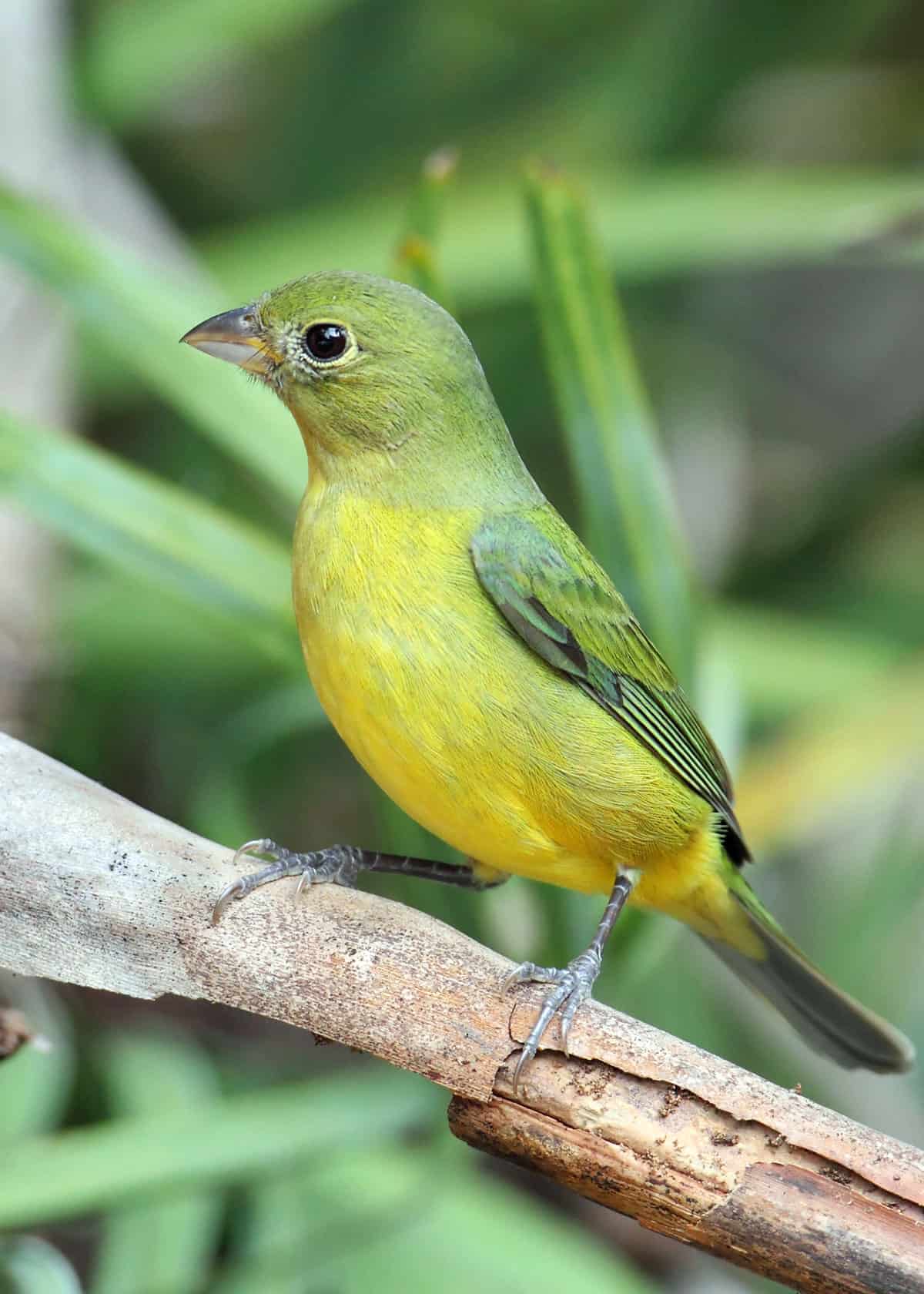
There have also been reports of painted buntings engaging in polygamy where one male mates with multiple females.
These females live together in the same territory, and the male defends them both.
15. At what age do painted buntings lay eggs?
Painted buntings start mating and laying eggs at roughly a year of age.
16. How often do painted buntings lay eggs?
They can lay several broods per mating season since their incubation period is less than two weeks; they just have to wait for their hatchlings to grow up and leave the nest before they can start reproducing again. This usually takes about a month.
17. How many eggs does the painted bunting lay?
Female painted buntings usually lay 3 – 4 eggs at a time and they’re about 1 – 2 centimetres wide.
18. What color are painted bunting eggs?
Painted bunting eggs are white with a gray or blue-gray tint, and they have dark brown spots on the shells.
19. What is the painted bunting’s call?
There are several ways that painted buntings communicate. Their primary vocalization is a simple “plick” that they use to call others or advertise their territory.
They’re also songbirds that can carry a sweet tune, but it’s for a purpose: they exchange bursts of sharp, high-pitched notes to convey messages to other members of the species.
20. Are painted buntings loud?
While not particularly loud in terms of volume, painted buntings can sing to each other for uninterrupted bursts of 30 seconds or more.
This gives them a semi-earned reputation for being noisy.
21. Do painted buntings have any special flight patterns?
Yes. Painted buntings have several unique flight patterns that aren’t seen in other cardinals. For example, their “butterfly flight” uses slow, deep wing movements while their “moth flight” is a controlled descent with quivering wing motions.
These can be handy ways to spot them in the wild, especially if you’re looking for green-colored females that can camouflage themselves in trees; just look for the crazy flight patterns when they take to the air.
22. Where does the painted bunting live?
Painted buntings are native to the U.S. and Mexico. They live in various parts of Texas, Arkansas, Alabama, Oklahoma, George, Florida, and Louisiana.
In the winter, they migrate south to places like Cuba and the Bahamas.
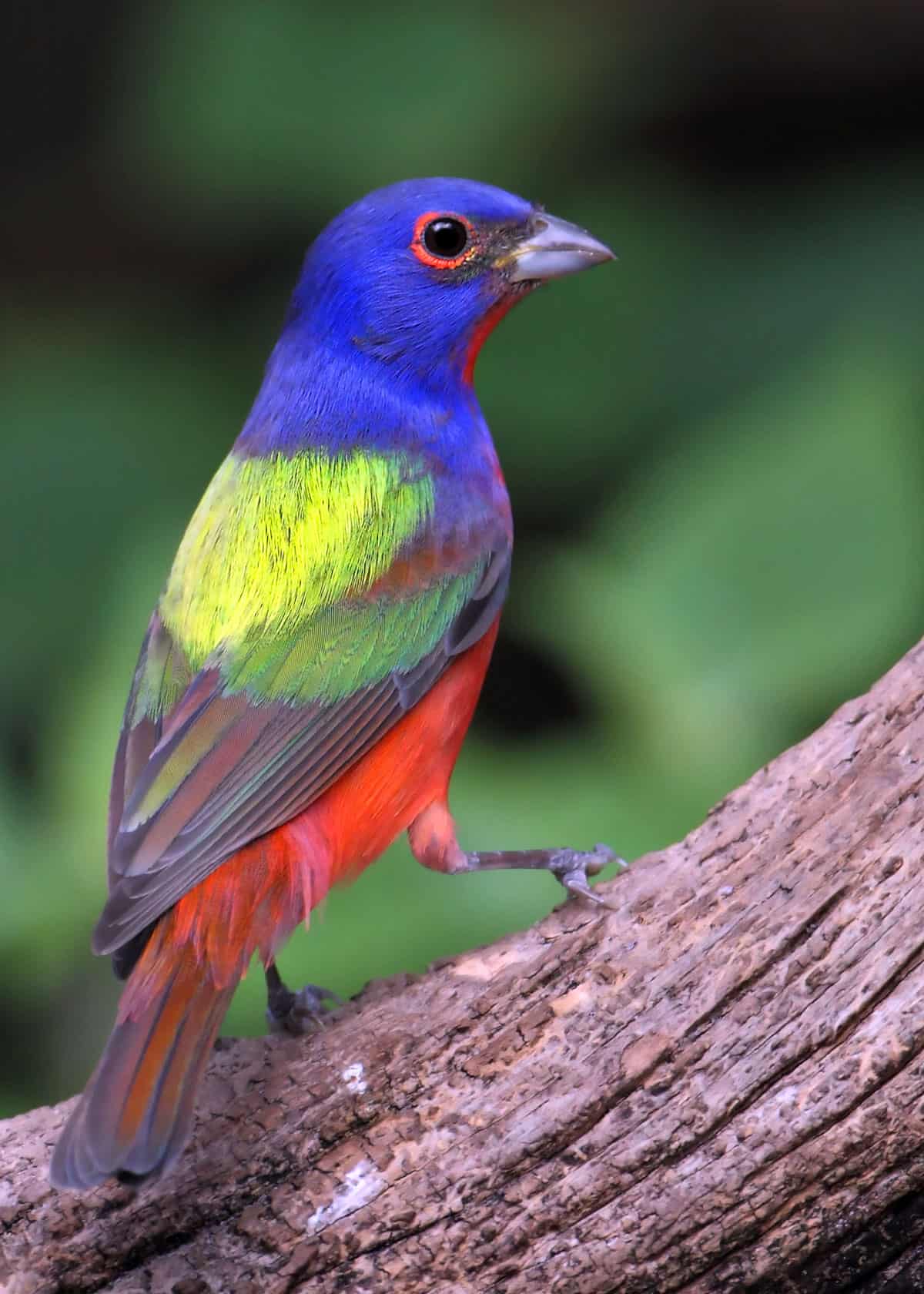
Occasionally, painted buntings are spotted in northern areas like New York and New Jersey. There have even been painted buntings recorded in Canada!
But this is rare, and birds that venture into colder climates are considered vagrants.
23. Does anything special happen during migration?
Some painted buntings will pause in the middle of a migration to molt. This is a process where they shed their old feathers to produce new ones.
If they’re flying to the Caribbean islands, they’ll stop in Mexico to get their makeover before moving on and completing their journey south.
Some birdwatchers travel to Mexico during the migration season for the express purpose of seeing the molting process in person.
24. What is the habitat of the painted bunting?
Like all birds, painted buntings like to be around trees. A unique characteristic of painted buntings is that they don’t actually live in trees.
They stick close to the ground in bushes, shrubs, hedges, thickets, and weeds. In the wild, they might occupy a tangled nest in the riparian zone between a river and a forest; in residential areas, they’ll creep into yards and gardens with lots of bushes and vines.
You can even find painted buntings beside major roads and highways! As long as there are thickets to protect them, they’re fine with most surroundings.
25. Where do painted buntings nest?
They tend to make their nests in groves, forests, woodlands and other areas with lots of branches and brambles.
Painted buntings aren’t very picky about location as long as they have adequate coverage.
26. How do you attract painted buntings?
If you’d like to see painted buntings in action, there are a few ways that you can coax them to your property:
- Plant shrubs and bushes. Give them a place to make their nests and sing their songs.
- Fill a bird feeder with their favorite seeds. The great thing about this option is that store-bought feed mixes usually include several different types of seeds, so if you’re already buying big bags to attract other birds, they can be used for painted buntings as well.
- Stop spraying pesticides. Painted buntings will take care of the bugs; you just have to give them the chance to raid your spiderwebs and beehives before you spray them.
- Offer a fresh water source. They’ll use it for both drinking and bathing. If you can afford it, a fountain or pond with moving water will attract more birds than still water.
27. Where can I see the painted bunting?
Painted buntings are popular attractions at zoos, wildlife centers and bird sanctuaries.
Their songs and colors are always a hit with the crowd, and when they’re kept away from predators, their population can flourish without a lot of human intervention.
You might also go on a bird-watching tour to see painted buntings in the wild. These tours are available throughout the United States, and their guides can help you track, spot, identify and photograph the painted buntings for your scrapbook.

Painted Like Picasso
These are just a few painted bunting facts that might help you during your next bird-watching expedition.
Instead of looking up into the trees, you’ll know to look down at the shrubs; instead of wasting time on yellow eggs, you’ll understand that you’re searching for white spotted ones.
Having accurate information on painted buntings can make all of the difference in spotting them. Happy searching!
What was your favorite fact? Did we miss anything? Do you still have unanswered questions? Join the discussion in the comments and we will try to help where we can!
Drew Haines is an animal enthusiast and travel writer. She loves to share her passion through her writing.
She graduated high school at sixteen and started her own business, Everywhere Wild Media. And she runs Everywhere Wild and JustBirding. She also guest blogs on Storyteller.Travel
She lived in Ecuador for 6 years and explored the Galapagos Islands. Currently based in N.S., Canada.





